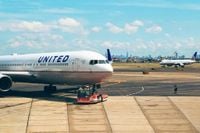Passengers across the United States faced a wave of flight delays and confusion this week as both American Airlines and United Airlines grappled with major technology glitches, grounding planes and testing the resilience of the aviation industry’s digital backbone. The incidents, which unfolded between September 23 and 24, 2025, left travelers stranded on tarmacs from Dallas to Chicago and reignited urgent questions about the vulnerability of airline IT systems and the promise—and limits—of artificial intelligence in keeping the skies moving.
American Airlines’ troubles began on Wednesday, September 24, when a technical issue impacting the airline’s maintenance applications forced the carrier to halt numerous departures. According to Express, passengers reported being stuck on the tarmac for hours, with some flights, including a Dallas-to-New York route, ultimately canceled. At Dallas Fort Worth International Airport, dozens of American flights were delayed, and the frustration quickly spilled over onto social media. One passenger wrote on X, “What is going on with @AmericanAir? They told us 2 plus hours ago about a national tech glitch. They say all planes have been grounded for the moment and we have been on the tarmac since then.”
In a statement to the Express, an American Airlines spokesperson acknowledged the problem: “American is aware of a technical issue impacting some of our maintenance applications. No flights have been canceled at this time and our teams are actively troubleshooting. We apologize to our customers for the inconvenience.” The airline attempted to minimize disruption by “utilising alternative procedures for closing out flights,” but this workaround led to a cascade of delayed departures nationwide. According to Bloomberg, the delays swelled to more than 830 flights—roughly 28% of American’s mainline operations—affecting cities such as Philadelphia, Miami, Chicago, Tampa, and Austin.
The timing of American’s crisis was particularly unfortunate, coming just hours after United Airlines had its own digital meltdown. On the night of September 23, United temporarily grounded all flights in the US and Canada due to a connectivity failure. As reported by IBTimes, the ground stop began just before midnight Central Time, after United asked the Federal Aviation Administration (FAA) to halt all departures. The disruption lasted less than an hour, but it caused significant delays and confusion at major hubs including Chicago, Newark, Denver, and Houston.
United’s spokesperson described the issue as a “brief connectivity issue” and assured that “operations had since returned to normal.” The FAA confirmed it had issued the ground stop at United’s request but offered little detail about the nature of the failure. Notably, this was the second time in less than eight weeks that United had experienced such a system-wide halt. In early August, a separate technical fault led to widespread delays, affecting thousands of passengers and prompting internal reviews, according to IBTimes. The earlier outage involved United’s Unimatic system, a critical software platform that tracks flight information and feeds data to other operational systems.
While United’s latest glitch was resolved quickly, the recurrence of these failures has sparked a wider debate about the airline industry’s dependence on centralized digital infrastructure. As IBTimes points out, modern aviation relies on complex networks for everything from flight scheduling and crew assignments to passenger check-in and air traffic coordination. This interconnectedness brings efficiency but also creates single points of failure—when a key system goes down, the entire operation can grind to a halt.
Some experts argue that artificial intelligence could offer a solution, providing predictive algorithms, anomaly detection, and decentralized data processing to identify and address technical issues before they escalate. The aviation industry has already begun experimenting with AI in areas like predictive maintenance and passenger flow modeling, but its adoption in core operational systems remains limited. After the latest disruptions, industry observers are urging airlines and regulators to invest more aggressively in intelligent systems that can provide redundancy and resilience. As IBTimes notes, “the debate it has sparked is already reshaping how the industry thinks about risk, reliability and innovation.”
For American Airlines, this week’s problems were compounded by recent history. Less than a week before the maintenance application glitch, American faced another major disruption at Dallas-Fort Worth International Airport. On September 19 and 20, fiber optic cables feeding data to an air traffic control facility were mistakenly cut, leading to the cancellation of nearly 700 flights and affecting more than 100,000 passengers, according to Bloomberg. The repeated technical setbacks have left many travelers exasperated. One American Airlines passenger vented on X, “Another delay @AmericanAir. Flight 402. Pilot just announced some electrical issues that need to be addressed creating some manual operations that will delay us. Some day I pray I get to fly on an on time American Airlines flight.”
Despite the chaos, both American and United have tried to reassure customers. American Airlines has stated that, in the event of a delay or cancellation, it will “rebook you on the next flight with available seats” and “reroute your bags automatically when you check in for your new flights.” The company has encouraged passengers to use its app, website, or airport kiosks to view or change their trips. United, meanwhile, has not disclosed whether AI tools played any role in diagnosing or resolving their recent glitches, nor has it commented on plans to integrate such systems in the future.
The FAA, for its part, has not announced a formal investigation into the United incident but continues to work with carriers to improve system reliability. Ground stops, the agency explains, are typically issued when aircraft must remain on the ground due to safety, equipment, or infrastructure concerns and are often implemented with little warning.
For travelers, the impact of these digital meltdowns is all too real. Delays ripple through the system, missed connections pile up, and uncertainty reigns. The frustration is palpable—not just for those stuck in airport terminals, but for an industry under increasing pressure to modernize in the face of growing passenger volumes and rising digital threats. Whether artificial intelligence will ultimately deliver the resilience airlines need is still an open question. But as the events of this week have shown, the stakes for getting it right could hardly be higher.
As airlines scramble to patch up their digital infrastructure and restore passenger confidence, the need for robust, adaptive systems has never been clearer. The hope is that the next time a glitch strikes, it won’t bring the world’s busiest skies to a standstill.



